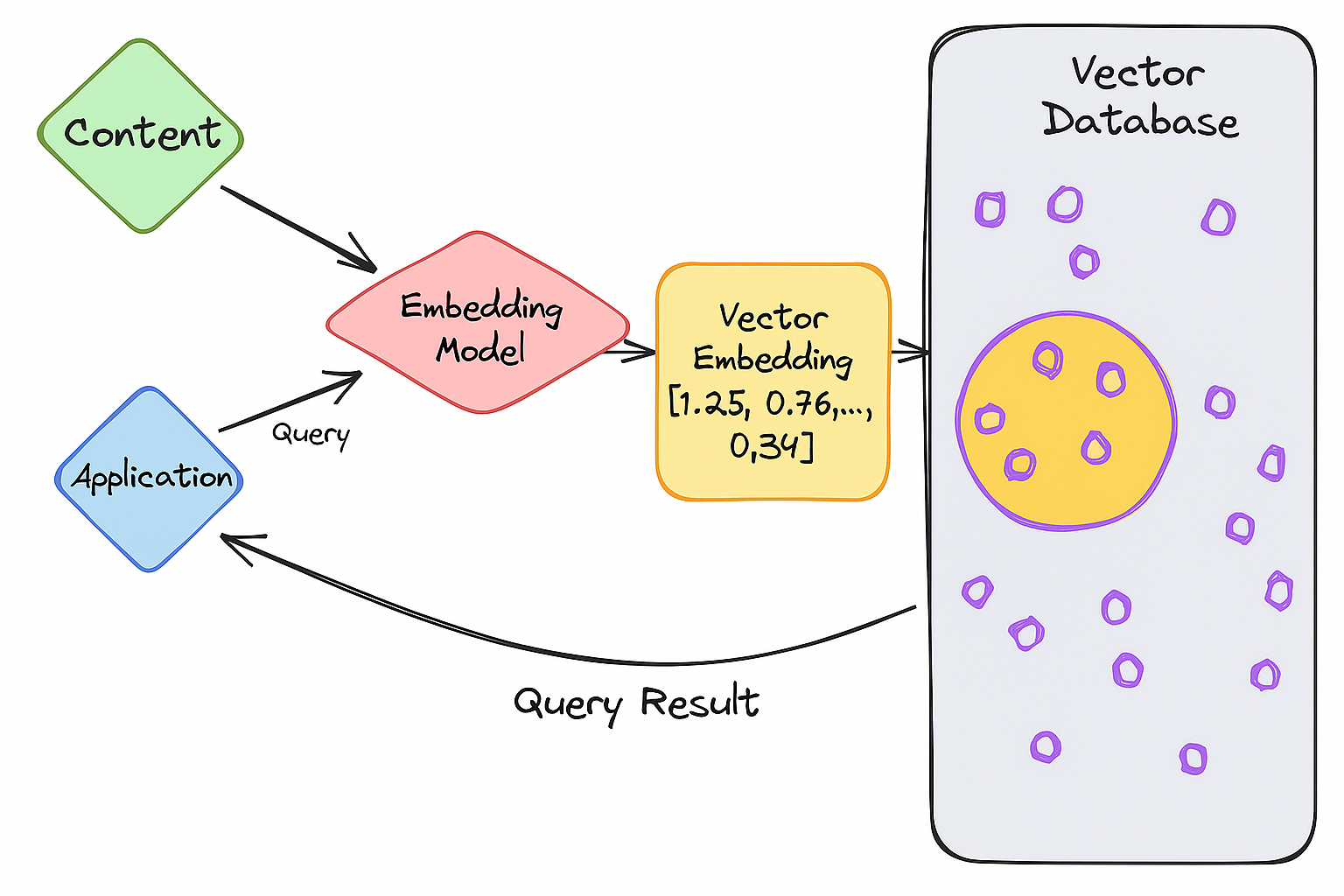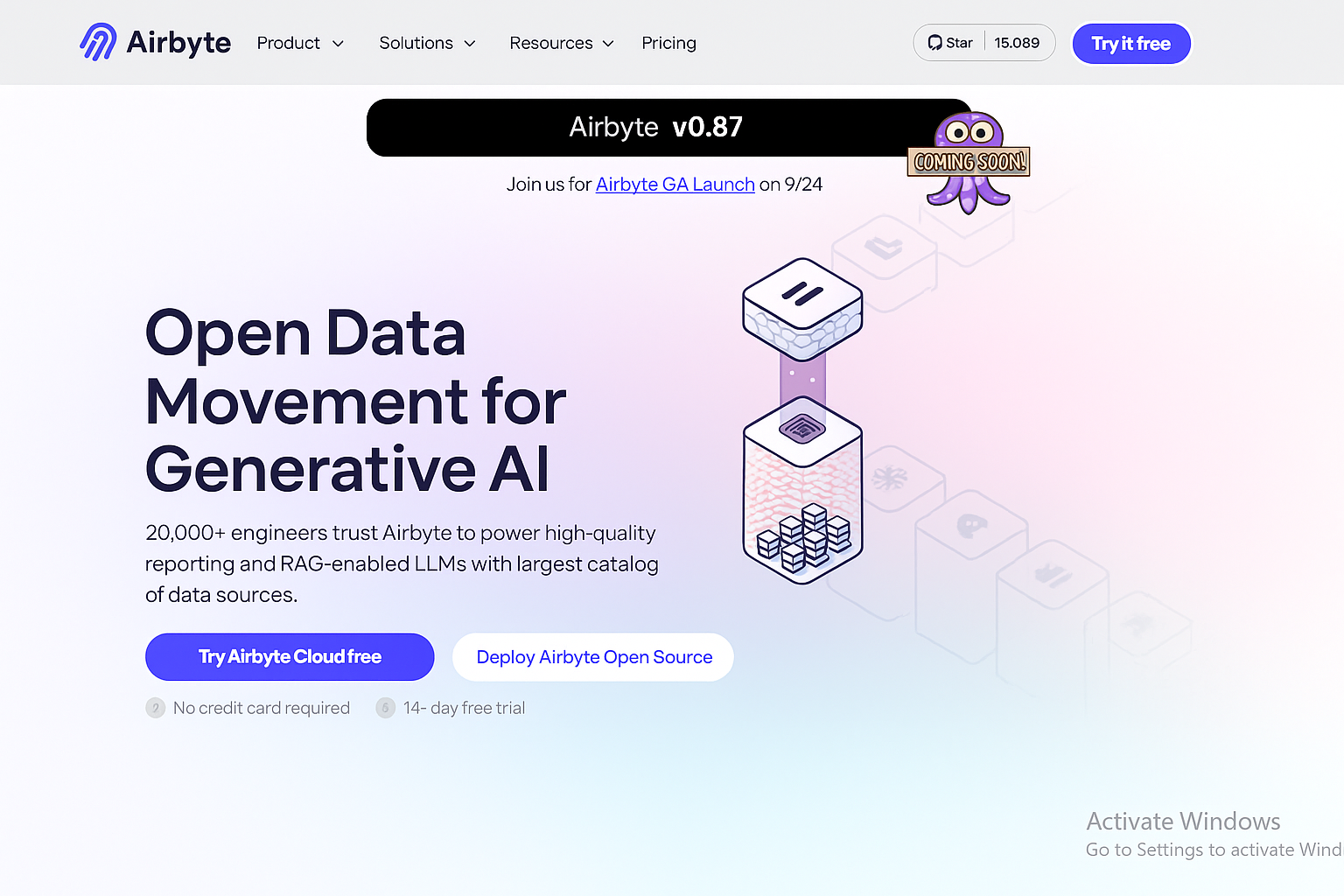Pinecone Vector Database: A Complete Guide
Summarize this article with:
✨ AI Generated Summary
Pinecone is a fully managed, serverless vector database optimized for fast, scalable similarity search across massive datasets, ideal for semantic search, recommendation systems, and RAG applications. Key features include:
- Automatic scaling and infrastructure management with a serverless architecture
- Real-time data ingestion and hybrid search combining vector similarity with metadata filtering
- Seamless integration with modern data stacks and support for multi-modal and enterprise-grade data governance
- Advanced techniques for embedding interpretability and privacy preservation
- Integration with tools like Airbyte for building reliable, flexible data pipelines
Pinecone is a fully managed vector database built for fast similarity search at scale. It uses vector embeddings to deliver sub-second queries across millions of data points, making it ideal for semantic search, recommendation systems, and RAG applications. This guide covers Pinecone's core capabilities, implementation strategies, and integration patterns to help you get started.
What Makes Pinecone the Leading Vector Database Solution?
A vector database helps you store and manage data as numerical vectors, enabling complex and fast searches in large datasets. It allows you to quickly compare vector similarities to find and rank similar data in large datasets.
Many vector databases are available to perform these tasks, including Pinecone, Weaviate, Chroma, and FAISS (Facebook AI Similarity Search). Pinecone is considered a leading option due to its ease of use, scalability, and cloud-native real-time indexing, making it a popular choice for enterprise production environments.
Pinecone's architecture delivers superior performance through its serverless design and managed infrastructure. The platform automatically handles scaling, optimization, and maintenance tasks that typically consume significant engineering resources. This approach allows your team to focus on building applications rather than managing database infrastructure.
The platform's success stems from its ability to maintain consistent sub-second query performance across massive datasets. Pinecone's hybrid search capabilities combine vector similarity with metadata filtering, enabling complex queries that traditional databases cannot handle efficiently.

Understanding Pinecone's Core Functionality
Pinecone leverages vector embeddings to quickly manage and search large datasets. It allows you to create and store vectors for the content you want to index. When you make a query, Pinecone generates embeddings for it using the same model and searches the database for similar vectors.
The database returns results based on how closely they match the query, showing relevant content. This approach enables semantic search capabilities that understand context and meaning rather than relying solely on keyword matching.
How Does Pinecone's Vector Database Architecture Work?
Pinecone uses an index as the primary organizational unit for managing vector data. It enables you to store vectors and facilitate similarity searches based on specified metrics, like cosine similarity. While setting up an index, you must define vector dimensions and similarity measures according to your needs.
The platform's architecture has evolved significantly to support modern AI workloads. Pinecone now uses log-structured merge trees to dynamically balance indexing strategies based on workload patterns. This approach optimizes small slabs for agentic workloads using scalar quantization while employing partition-based indexing for large-scale datasets.
Creating and Managing Your First Index
Setting up your first Pinecone index requires several straightforward steps that establish the foundation for your vector search capabilities.
1. Access Your Pinecone Dashboard
Visit the Pinecone website and log in to your account to access the dashboard. You have two options to get started: Create your first index or load sample data to examine Pinecone's features.
2. Configure Your Index Settings
If you want to create an index, click Index in the left-side panel on the dashboard. Select Create Index and configure it by naming it, setting dimensions and metrics, and choosing between serverless or pod-based deployment.
3. Explore Integration Options
After creating your index, you can explore how to integrate data into it or how to create a new index using code. This enables you to leverage Pinecone's capabilities for your specific use cases.
If you choose to load data, click Load sample data, which provides a pre-configured dataset with metadata. Once you load the data, a new index will appear in the indexes column. This helps you understand how to structure and utilize metadata effectively.
What Are the Key Features That Make Pinecone Vector Database Exceptional?
Pinecone vector database offers various features to enhance search capabilities in high-dimensional data. These capabilities have been continuously enhanced to meet the demands of modern AI applications.
1. Complete Infrastructure Management with Serverless Architecture
Pinecone handles all maintenance and infrastructure tasks, such as scaling, updates, and monitoring. The platform's serverless design decouples storage from compute, enabling automatic scaling based on demand without manual configuration. This provides a hassle-free environment for application development by managing technical details and operational complexities of the databases.
2. Enterprise-Grade Scalability and Performance
Pinecone offers robust scalability features to efficiently manage vast amounts of high-dimensional vector data. Its horizontal capabilities allow it to adapt to complex machine-learning tasks and ensure smooth performance as data and usage grow.
3. Real-Time Data Ingestion and Processing
Pinecone supports immediate addition and indexing of new data, ensuring your data is always up-to-date. The platform's log-structured ingestion pipeline separates write operations from query processing, enabling continuous data streaming while maintaining query consistency.
4. Seamless Integration with Modern Data Stack
Pinecone's user-friendly API simplifies the integration of vector search into existing machine-learning workflows and data systems. The platform provides native compatibility with modern cloud platforms—including Snowflake, Databricks, and BigQuery, enabling organizations to leverage their existing data-infrastructure investments.
What Are the Main Challenges When Implementing Pinecone Vector Database?
Implementing Pinecone vector database in enterprise environments presents several technical and operational challenges that require strategic planning and careful execution.
Understanding Vector Embeddings and Optimization
Selecting appropriate embedding models and optimizing their quality is crucial. Factors to consider include embedding dimensionality, semantic accuracy, and computational efficiency when choosing between models like OpenAI's text-embedding models or domain-specific alternatives.
The quality of your embeddings directly impacts search accuracy and relevance. You must establish validation frameworks to ensure consistent performance across different data types and use cases.
Managing Cost Structure and Resource Allocation
Pinecone's serverless architecture uses consumption-based pricing. Organizations must balance performance requirements against budget constraints, particularly with high-dimensional vectors or frequent query patterns.
Understanding usage patterns helps optimize costs while maintaining performance. Regular monitoring and adjustment of index configurations can significantly impact overall expenses.
Generating Quality Vectors and Maintaining Accuracy
Consistent vector quality across diverse data sources is challenging. Validation frameworks, monitoring embedding quality metrics, and retraining models when accuracy declines are essential for maintaining system effectiveness.
Data drift and model degradation can impact search quality over time. Implementing monitoring systems that track embedding quality and search relevance helps maintain optimal performance.
Integration Complexity with Existing Systems
Integrating Pinecone often requires architectural changes and custom development work, including data transformation pipelines and real-time synchronization between operational systems and vector indexes.
Legacy systems may require significant modifications to support vector search capabilities. Planning these integrations carefully prevents disruption to existing operations while enabling new functionality.
Optimizing Performance for Specific Use Cases
Different use cases require distinct optimization approaches, including index settings, resource allocation, and caching strategies. Real-time applications have different requirements than batch processing workflows.
Performance tuning involves balancing query speed, accuracy, and cost. Understanding your specific performance requirements helps guide configuration decisions and resource allocation.
How Does Pinecone's Serverless Architecture Optimize Performance and Cost?
Pinecone's serverless approach fundamentally changes how vector databases handle scaling, performance, and cost optimization. This architecture addresses traditional pain points in database management.
Dynamic Storage-Compute Separation
Storage is decoupled from compute, allowing each to scale independently. Intelligent caching keeps hot data in high-performance tiers, while cold data resides in cost-effective object storage.
This separation enables optimal resource allocation based on actual usage patterns. You pay only for the resources you use, eliminating the need for capacity planning and over-provisioning.
Adaptive Indexing for Optimal Performance
Pinecone automatically selects lightweight or partition-based indexing strategies based on dataset size and workload, using log-structured merge trees for efficient ingestion and query performance. This dynamic approach optimizes performance for different use cases without manual tuning.
The system continuously adapts to changing workload patterns. As your data grows or usage patterns change, the indexing strategy adjusts automatically to maintain optimal performance.
Cost Optimization Through Consumption-Based Pricing
Separate pricing for storage, queries, and writes enables granular cost control. Resources scale automatically, eliminating over-provisioning and reducing total cost of ownership.
This pricing model aligns costs with actual value delivered. Organizations can start small and scale up as their applications grow, making vector search accessible for projects of any size.
How Can You Implement Advanced Integration Patterns for Modern Data Stack Compatibility?
Modern data architectures require sophisticated integration patterns that combine multiple search modalities and data sources. Pinecone supports these advanced patterns through flexible APIs and architecture.
Hybrid Search Architecture Implementation
Combine dense vector search, sparse keyword search, and metadata filtering. Use orchestration layers that merge results via reciprocal rank fusion or weighted scoring to deliver comprehensive search results.
Hybrid approaches leverage the strengths of different search methods. Vector search captures semantic similarity while keyword search handles exact matches, providing comprehensive coverage.
Real-Time Data Pipeline Integration
Change-data-capture mechanisms stream updates through embedding-generation pipelines to keep vector indexes fresh. Frameworks like Apache Kafka orchestrate real-time data flow between operational systems and vector indexes.
Real-time integration ensures search results reflect the latest data. This capability is crucial for applications requiring immediate access to updated information.
Multi-Modal Data Integration Strategies
Implement specialized embedding models for text, image, and audio data. Use alignment techniques so vectors from different modalities share a comparable semantic space for cross-modal search capabilities.
Multi-modal integration enables unified search across different content types. Users can search for images using text queries or find similar audio content using visual inputs.
Enterprise Data Governance Integration
Use namespace isolation, role-based access control, and audit trails for compliance. Integrate with identity management systems and privacy-protection techniques like differential privacy to meet regulatory requirements.
Governance integration ensures vector search capabilities align with organizational policies. This includes data access controls, audit requirements, and privacy protection measures.
What Advanced Techniques Enhance Pinecone Implementation?
Beyond basic implementation, advanced techniques can significantly improve the effectiveness and reliability of your Pinecone deployment.
Interpretable Embedding Design for Enhanced Performance
Traditional embeddings are opaque, making it difficult to understand why certain results are returned. Techniques like language-guided embedding alignment use large language models to create interpretable dimensions, enabling explainable AI and easier debugging.
Cross-modal correlation approaches like CLIP further improve interpretability, allowing applications to present visual or textual explanations for similarity results. This capability is increasingly important for applications requiring transparency.
Advanced Privacy Preservation Frameworks
Embedding inversion attacks can potentially reconstruct sensitive data from vectors. Defense mechanisms include homomorphic encryption for encrypted similarity operations, secure enclaves for isolated computation, and differential privacy to bound information leakage.
Continuous monitoring of security risks is essential for maintaining compliance with regulations such as HIPAA and GDPR, though monitoring inversion-vulnerability scores specifically is not explicitly required under these regulations. These frameworks ensure vector search capabilities don't compromise data privacy.
How Can You Build a Pinecone Vector Database Pipeline Using Airbyte?

Airbyte offers flexible deployment for complete data sovereignty, enabling you to move data across cloud, on-premises, or hybrid environments with one convenient UI. With 600+ pre-built connectors and AI-assisted connector building capabilities, Airbyte simplifies the process of building data pipelines to Pinecone.
The platform provides AI-ready data movement that handles both structured and unstructured data together, preserving context essential for effective vector embeddings. Below is a step-by-step guide to set up data pipelines to Pinecone using Airbyte with a CSV file as the source.
1. Configure Flat File as Source
- Log in to your Airbyte account.
- On Airbyte's dashboard, click Sources on the left-side panel.
- Use the search bar to find the File connector.
- Fill in all the details, such as File Format, Storage Provider, and URL.
- Click Set Up Source.
2. Configure Pinecone as Destination
Prerequisites:
- An API-access account with OpenAI or Cohere (depending on your embedding method).
- A Pinecone project with a pre-created index that matches the dimensionality of your embedding method.
Steps:
- On Airbyte's dashboard, select Destinations.
- Search Pinecone in the search bar and click on its tile.
- Fill in all the details: Chunk Size, OpenAI API key, Pinecone Index, Pinecone Environment, and Pinecone API key.
- Click Set Up Destination.
3. Establish a Connection
- On Airbyte's dashboard, click Create your connection.
- Select the Source and Destination, then define the frequency of your data syncs.
- Click Test Connection to verify your setup.
- If the test is successful, click Set Up Connection.
Airbyte's 99.9% uptime reliability ensures your pipelines work consistently, allowing teams to focus on using data rather than managing pipeline maintenance. The platform's capacity-based pricing scales with performance and sync frequency rather than data volume.
Conclusion
Pinecone vector database offers a powerful solution for organizations seeking fast, scalable similarity search capabilities across massive datasets. Its serverless architecture eliminates infrastructure management while delivering consistent sub-second performance, even as data volumes grow. By leveraging Airbyte's 600+ connectors and flexible deployment options, teams can build efficient data pipelines to Pinecone while maintaining complete data sovereignty and focusing on creating value rather than managing infrastructure.
Frequently Asked Questions
What Is the Pinecone Vector Database?
Pinecone is a vector database designed for high-performance similarity searches in high-dimensional data.
Is Pinecone DB Free?
Pinecone offers a free tier with limited usage; production workloads require paid plans.
What Is a Pinecone in LLM?
Pinecone integrates with Large Language Models (LLMs) to provide scalable, real-time retrieval-augmented generation.
Is Pinecone Legit?
Yes. Pinecone is widely used and trusted across industries.
What Are the Benefits of the Pinecone Database?
Key benefits include efficient similarity searches, automatic scalability, real-time data processing, and seamless integration with modern data stacks.

.webp)
